The Generic Profiles for VSEs Developing
Software
•
–This page
describes the concept of Profiles, the Generic Profiles and the four Profiles of the Generic Profile
Group for VSEs developing software.
Profiles
The core characteristic of the
entities targeted by ISO/IEC 29110 is size, however there are other
aspects and characteristics of VSEs that may affect profile preparation
or selection, such as: Business Models (commercial, contracting,
in-house development, etc.); Situational factors (such as criticality,
uncertainty environment, etc.); and Risk Levels [1]. Creating one profile
for each possible combination of values of the various dimensions
introduced above would result in an unmanageable set of profiles.
Accordingly VSE’s profiles are grouped in such a way as to be applicable
to more than one category. Profile Groups are a collection of profiles
which are related either by composition of processes (i.e. activities,
tasks), or by capability level, or both [2].
The Generic Profile Group
The Generic Profile Group has been defined [3] as
applicable to a vast majority of VSEs that do not develop critical
systems or software and have typical situational factors. The Generic Profile Group
is a collection of four profiles (Entry, Basic Intermediate, Advanced),
providing a progressive approach to satisfying a vast majority of VSEs.
|
Profile Group |
Profile |
|
Generic |
Entry |
|
Generic |
Basic |
|
Generic |
Intermediate |
|
Generic |
Advanced |
Note: Part 1,
Part 3 and Part 5 are available at no cost from ISO:
http://standards.iso.org/ittf/PubliclyAvailableStandards/index.html
The set
of documents is intended to be used by a VSE to establish processes to implement
any development approach or methodology including, e.g., agile,
evolutionary, incremental, test driven development, etc. based on the
organization or project needs of a VSE.
The Entry Profile
VSEs Targeted by the Entry Profile are VSEs working on
small projects (e.g. at most six person-months effort) and for start-up
VSEs.
Characteristics of the Targeted VSEs:
-
Primarily involved in the design and/or coding of
minor software package
-
Do not have significant experience with large
software development projects, and so do not attract contract jobs
from larger software firms
-
Personnel often relatively inexperienced
-
Often lack discipline in product development tasks:
focus mostly in coding activities
-
Lack of tangible process assets
-
Limited access to investments and loans
-
May lack credibility and need for a reference (e.g.
from a previous customer)
-
Customers may impose a software development process
Objectives of the Entry Profile
-
The Entry Profile should provide a foundation for a
migration to the Basic Profile Processes.
-
The Entry Profile could be used by VSEs to help them
implement a start-up management process and an implementation process.
The Entry Profile is composed of two
processes (see figure below), a Project Management process and a
Software Implementation process:
-
The purpose of the Project
Management process is to establish and carry out in a systematic way the
tasks of the software implementation project, which allows complying with
the project’s objectives in the expected quality, time and cost.
-
The purpose of the Software
Implementation process is the systematic performance of the analysis,
design, construction, integration and tests activities for new or modified
software products according to the specified requirements.
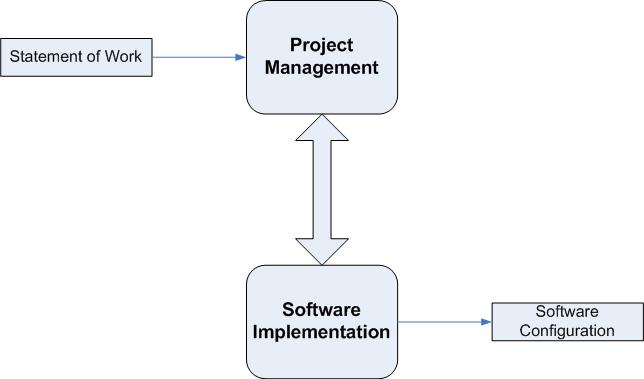
Processes
of the Entry Profile (ISO/IEC TR 29110-5-1-1: 2012)
Project Management and Software Implementation
Objectives of the Entry Profile
Since the Entry Profile has been developed using
the Basic Profile (see below), to illustrate was has been added or
deleted the following convention is used:
- Information added or modified to the
Basic Profile is shown in blue
while information deleted is shown like this:
strike
out.
The objectives of the Project Management (PM)
Process of the Entry profile, listed in ISO/IEC TR 29110-5-1-1: 2012, are:
|
Objective ID
|
Objectives
|
|
PM.01 |
The
Project Plan
for the execution of the project is developed according to
the Statement of Work
and reviewed and accepted by the Customer. The tasks and
resources necessary to complete the work are sized and
estimated.
|
|
PM.02 |
Progress of the project monitored against the
Project Plan
and recorded in the Progress Status Record.
Corrections to remediate problems and deviations from the plan
are taken when project targets are not achieved.
Closure of the project is performed to get the Customer
acceptance documented in
the Acceptance Record.
|
|
PM.03 |
The
Changes Requests
are addressed
through their reception and analysis.
Changes to
the
software requirements are evaluated for
cost, schedule and technical impact.
impact.
|
|
PM.04 |
Review meetings with the Work Team and the Customer are held.
Agreements are registered and tracked. |
|
PM.05 |
Risks
are identified as they develop and during the conduct of the
project.
|
|
PM.06 |
A software
Version Control Strategy
is developed. Items of
Software Configuration
are identified, defined and baselined. Modifications and
releases of the items are controlled and made available to the
Customer and Work Team. The storage, handling and delivery of
the items are controlled.
Items of Software Configuration are identified and controlled.
|
|
PM.07 |
Software Quality Assurance is performed to provide assurance
that work products and processes comply with the
Project Plan
and
Requirements Specification.
|
The Project Management Process has the following activities
(see figure below
- PM.1 Project Planning
- PM.2 Project Plan Execution
- PM.3 Project Assessment and Control
- PM.4 Project Closure
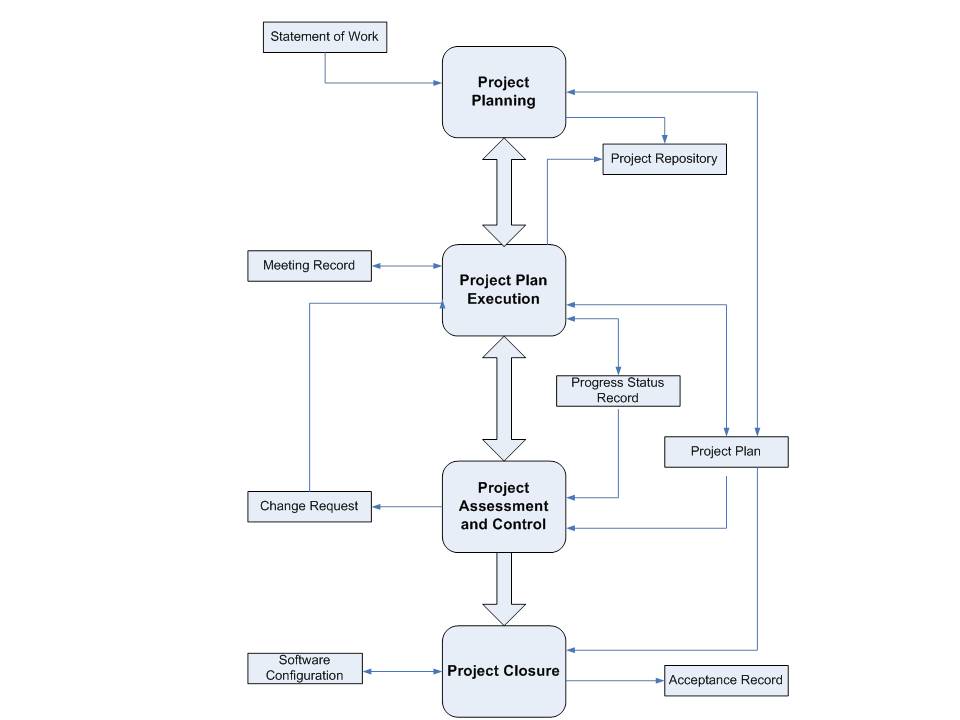
Project Management process
diagram of the Entry Profile (ISO/IEC TR 29110-5-1-1)
------------------------------------------------------------------------------------------------------------------
The objectives of the Software Implementation (SI)
Process of the Entry profile, listed in ISO/IEC TR 29110-5-1-1: 2012, are:
|
Objective ID
|
Objectives
|
|
SI.01 |
Tasks of the activities are performed through the
accomplishment of the current
Project Plan. |
|
SI.02 |
Software requirements
and their interfaces
are defined, analyzed for correctness and testability, approved
by the Customer,
baselined
and communicated.
|
|
SI.03 |
Software components are identified.
Software architectural and detailed design is developed and
baselined. It describes the software components and internal and
external interfaces of them. Consistency and traceability to
software requirements are established.
|
|
SI.04 |
Software
components
defined by the design
are produced. Unit test are
defined and
performed to verify the consistency with
software
requirements.
and the design. Traceability to the requirements and design are
established.
|
|
SI.05 |
Software
is produced .
performing integration of
Software Components
are integrated
and verified using
Test Cases and Test Procedures.
Results are recorded at the
Test Report.
Defects are corrected
and consistency and traceability to
Software Design
are established.
|
|
SI.06 |
Software configuration is prepared for delivery.
A
Software Configuration,
that meets the
Requirements Specification
as agreed to with the Customer, which includes user, operation
and maintenance documentations is integrated, baselined and
stored at the
Project Repository.
Needs for changes to the
Software Configuration
are detected and related
Change Requests
are initiated.
|
|
SI.07 |
Verification and Validation Tasks of all required work products
are performed
using the defined criteria
to achieve consistency among output and input products in each
activity. Defects are identified, and corrected;
records are stored in the Verification/Validation Results.
|
The Software Implementation Process has the following
activities (see figure below)
-
SI.1 Software Implementation
Initiation
- SI.2 Software Requirements Analysis
-
SI.3 Software Component
Identification
-
SI.4 Software Construction
-
SI.5 Software Integration and Tests
-
SI.6 Product Delivery
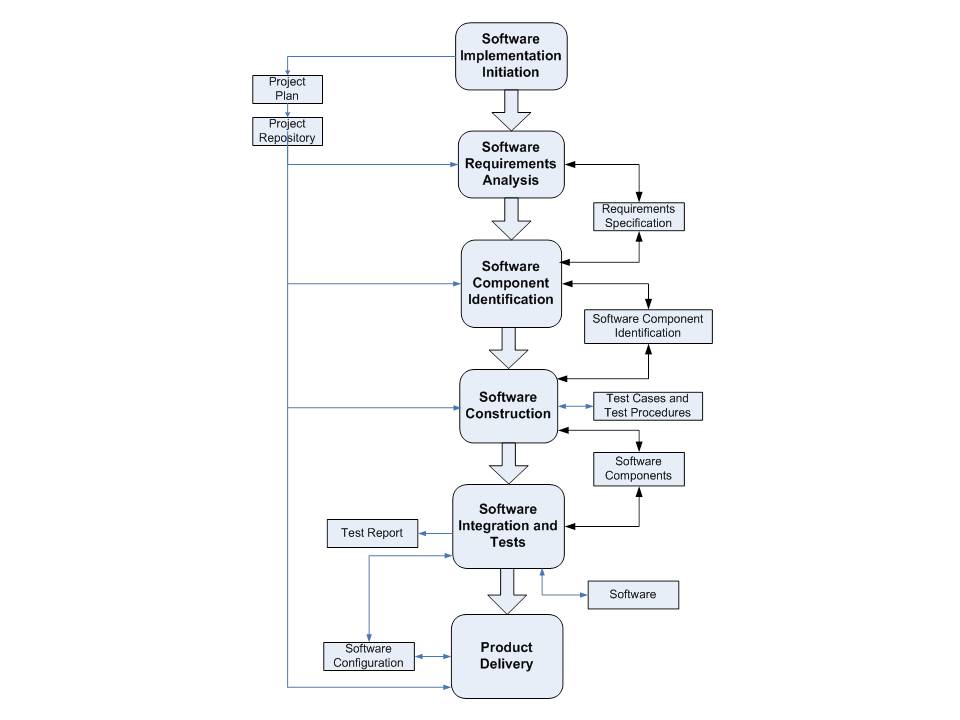
Software Implementation Process Diagram
of the Entry Profile (ISO/IEC TR 29110-5-1-1)
------------------------------------------------------------------------------------------------------------------
The Basic Profile
The basic profile describes software development of a
single application by a single project team with no special risk or situational
factors. The project may be to fulfill an external or internal contract. The
internal contract need not be explicit between the project team and their client
[1].
To use the
Guide ( i.e. Part 5) the VSE needs to fulfil the following entry conditions:
-
Project
statement of work is documented;
-
Feasibility of the project was
performed before its start;
-
Project team, including
project manager, is assigned and trained; and
-
Goods, services and
infrastructure to start the project are available.
The Basic Profile is composed of two
processes (see figure below), a Project Management process and a
Software Implementation process:
-
The purpose of the Project
Management process is to establish and carry out in a systematic way the
tasks of the software implementation project, which allows complying with
the project’s objectives in the expected quality, time and cost.
-
The purpose of the Software
Implementation process is the systematic performance of the analysis,
design, construction, integration and tests activities for new or modified
software products according to the specified requirements.

Processes
of the Basic Profile (ISO/IEC TR 29110-5-1-2: 2011)
Project Management and Software
Implementation Objectives of the Basic Profile
The objectives of the Project Management (PM) Process of
the Basic profile, as listed in ISO/IEC TR 29110-5-1-2: 2011, are:
|
Objectives ID |
Objectives |
|
PM.01 |
The
Project Plan for the execution of the project is developed
according to the Statement of Work and reviewed and accepted
by the Customer. The tasks and resources necessary to complete the
work are sized and estimated. |
|
PM.02 |
Progress of the project is monitored against the Project Plan
and recorded in the Progress Status Record.
Corrections to remediate problems and deviations from the plan are
taken when project targets are not achieved. Closure of the project
is performed to get the Customer acceptance documented in the
Acceptance Record. |
|
PM.03 |
The
Change Requests are addressed through their reception and
analysis. Changes to software requirements are evaluated for cost,
schedule and technical impact. |
|
PM.04 |
Review meetings with the Work Team and the Customer are held.
Agreements are registered and tracked. |
|
PM.05 |
Risks
are identified as they develop and during the conduct of the
project. |
|
PM.06 |
A
software Version Control Strategy is developed. Items of
Software Configuration are identified, defined and baselined.
Modifications and releases of the items are controlled and made
available to the Customer and Work Team. The storage, handling and
delivery of the items are controlled. |
|
PM.07 |
Software Quality Assurance is performed to provide assurance that
work products and processes comply with the Project Plan and
Requirements Specification. |
The Project Management Process has the following activities
(see figure below):
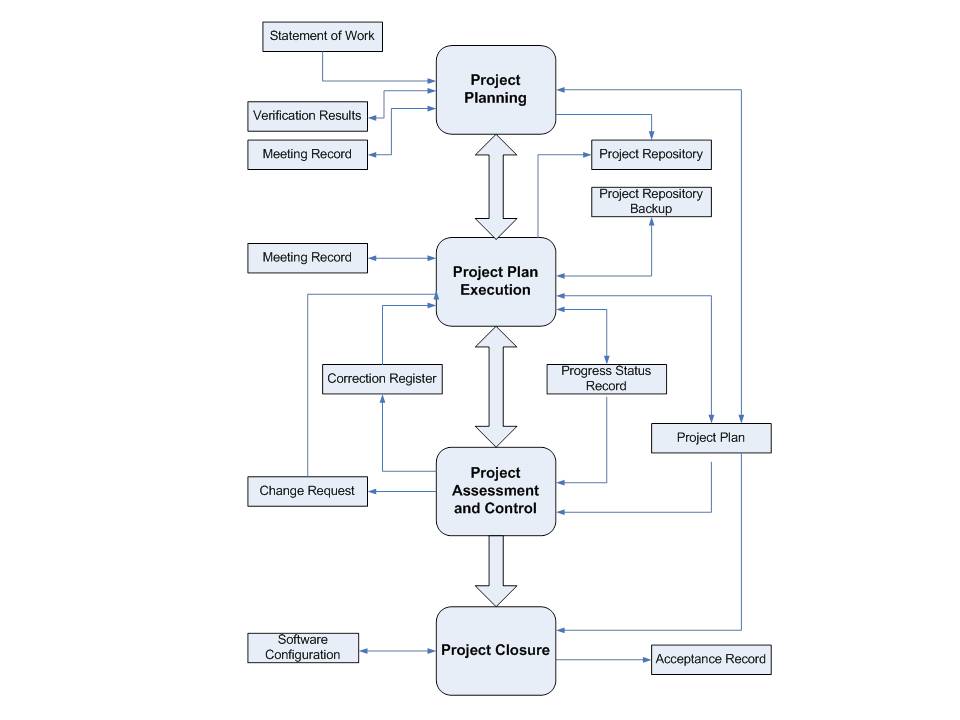
Project Management process
diagram of the Basic Profile (ISO/IEC TR 29110-5-1-2: 2011)
The objectives of the Software Implementation (SI)
Process of the Basic profile, as listed in ISO/IEC TR 29110-5-1-2: 2011, are:
|
Objectives ID |
Objectives |
|
SI.01 |
Tasks of the activities are performed through the accomplishment of
the current Project Plan. |
|
SI.02 |
Software requirements are defined, analyzed for correctness and
testability, approved by the Customer, baselined and communicated.
|
|
SI.03 |
Software architectural and detailed design is developed and
baselined. It describes the software components and internal and
external interfaces of them. Consistency and traceability to
software requirements are established. |
|
SI.04 |
Software components defined by the design are produced. Unit test
are defined and performed to verify the consistency with
requirements and the design. Traceability to the requirements and
design are established. |
|
SI.05 |
Software
is produced performing integration of software components and
verified using Test Cases and Test Procedures. Results are
recorded at the Test Report. Defects are corrected and
consistency and traceability to Software Design are
established. |
|
SI.06 |
A
Software Configuration, that meets the Requirements
Specification as agreed to with the Customer, which includes
user, operation and maintenance documentations is integrated,
baselined and stored at the Project Repository. Needs for
changes to the Software Configuration are detected and
related Change Requests are initiated. |
|
SI.07 |
Verification and Validation tasks of all required work products are
performed using the defined criteria to achieve consistency among
output and input products in each activity. Defects are identified,
and corrected; records are stored in the Verification/Validation
Results. |
The Software Implementation Process has the following
activities (see figure below):
-
SI.1 Software Implementation
Initiation
-
SI.2 Software Requirements
Analysis
-
SI.3 Software Architectural
and Detailed Design
-
SI.4 Software Construction
-
SI.5
Software Integration and Tests
-
SI.6 Product Delivery
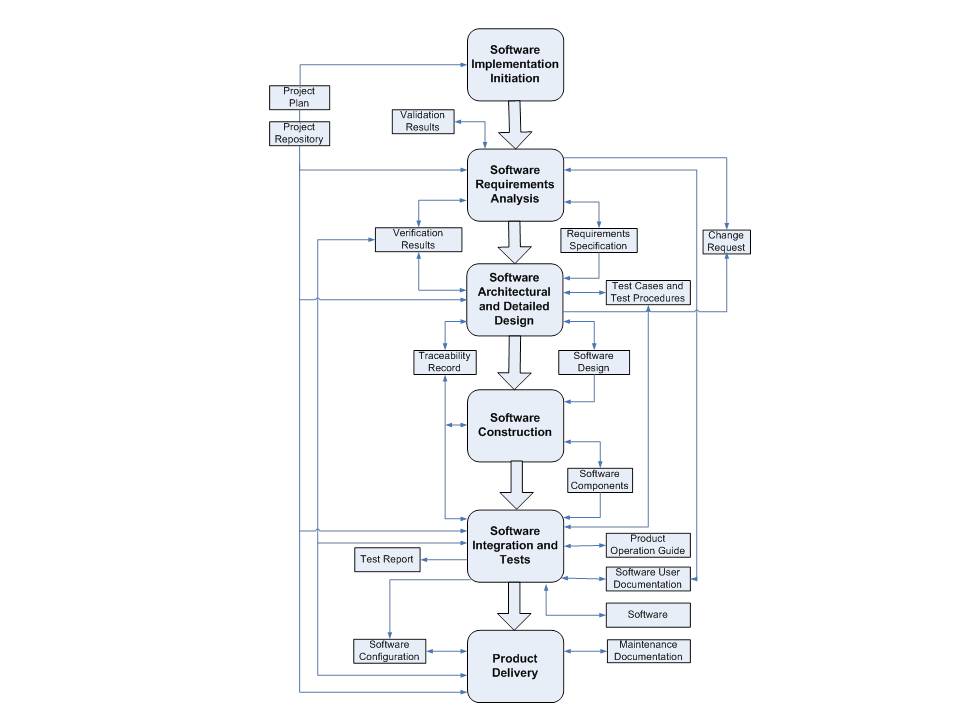
Software Implementation Process Diagram
of the Basic Profile (ISO/IEC TR 29110-5-1-2: 2011)
------------------------------------------------------------------------------------------------------------------
The Intermediate Profile
The Intermediate Profile guide describes the management of more than one project in parallel with more than one work team.
The purpose of the
Business Management (BM) process is to identify opportunities, evaluate
all in-place Agreements or requests from customers for fit with
organisational goals and resources, obtain and provide the VSE with the
necessary resources to perform all projects, monitor and evaluate all
projects, conduct lessons learned to improve the VSE and protect its
intellectual property and the security of its assets and information
items. The purpose of the Project Management (PM) process is to
establish and carry out in a systematic way the Tasks of the software
implementation process, which allows complying with the project’s
Objectives in the expected quality, time and costs. The purpose of the
Software Implementation (SI) process is the systematic performance of
the analysis, design, construction, integration and test activities for
new or modified software work products according to the specified
requirements. The purpose of the Acquisition Management (AM) process is
to obtain products and/or services required by the VSE. The execution
of the AM process is only required if a product/service needs to be
obtained from a supplier by the VSE (i.e. a conditional process).
The processes are interrelated (see
Figure below). The arrow connecting the AM process to the other
processes is dashed to indicate that this process is conditional.
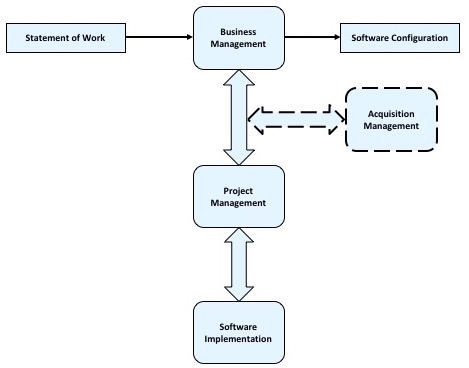
Intermediate Profile Processes
------------------------------------------------------------------------------------------------------------------
The Advanced Profile
The Advanced profile is targeted at VSEs which want
to sustain and grow as an independent competitive system and/or
software development business.
The Advanced profile has one new process that is not in the
Intermediate profile: Software Transition and Disposal process (STD).
The purpose of the Software Transition and Disposal
(STD) process is to move the software in an orderly, planned manner
into the operational status such that the system is functional and
operable in the operational environment of the Customer and to end the
existence of a system element or system for a specified intended use,
appropriately handle replaced or retired elements, and to properly
attend to identify critical disposal needs (e.g. per an agreement, per
organisational policy, or for environmental, safety, and security
aspects).
The arrow connecting the AM and the STD processses to the other
processes are dashed to indicate that these processes are conditional processes.

Advanced Profile Processes
------------------------------------------------------------------------------------------------------------------
Freely Available Documents
To obtain freely available ISO 29110 documents, select the document you want to obtain (see an example below).

Click on the 'downloadled' link (see below). A new page, titled 'Freely Available Standards',
will open. Then, identify the ISO 29110 document needed, click on the
ISO 29110 document and accept the ISO License Agreement. The document
should download automatically.
References
[1] Laporte, C.Y., Alexandre, S., O’Connor, R., A Software Engineering
Lifecycle Standard for Very Small Enterprises, in R.V. O’Connor et al. (Eds.):
EuroSPI 2008, CCIS 16, pp. 129–141.
[2] O’Connor, R.V., Laporte, C.Y., Towards the Provision of Assistance
for Very Small Entities in Deploying Software Lifecycle Standards, 11th
International Conference on Product Focused Software Development and Process
Improvement (Profes2010), Hosted by LERO, Ireland, June 21-23, 2010.
[3] ISO/IEC 29110-2-1:2015 Systems and software Engineering - Lifecycle Profiles
for Very Small Entities (VSEs) - Part 2-1: Framework and taxonomy.
ISO/IEC 29110-2-1:2015
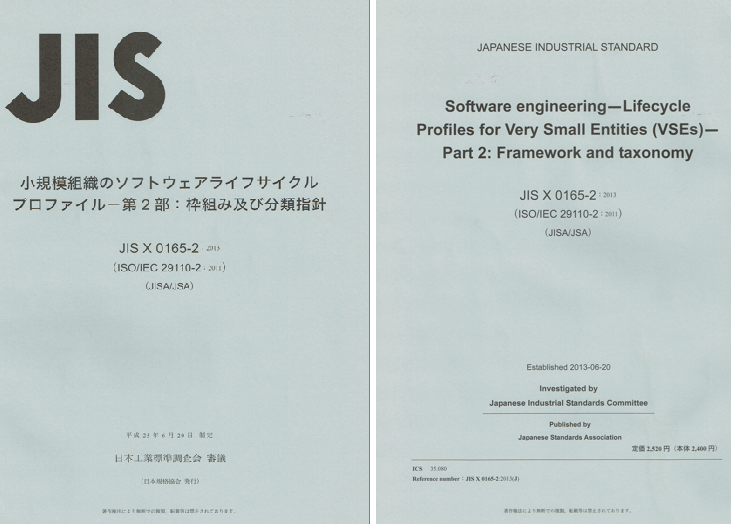
Part 2 has been translated in Japanese, Spanish and Portuguese
[4] ISO/IEC TR 29110-5-1-2 Software engineering --
Lifecycle profiles for Very Small Entities (VSEs) -- Part 5-1-2: Management and
engineering guide: Generic profile group: Basic profile.
ISO/IEC TR 29110-5-1-2-2011
ISO/IEC TR 29110-1 is available at no
cost at: http://standards.iso.org/ittf/PubliclyAvailableStandards/c062711_ISO_IEC_TR_29110-1_2016.zip
ISO/IEC TR 29110-3 is available at no cost at:
http://standards.iso.org/ittf/PubliclyAvailableStandards/c051152_ISO_IEC_TR_29110-3_2011.zip
ISO/IEC TR 29110-5-1-1 (Entry Profile) is available at no
cost at:
IEC TR 29110-5-1-1-2012(E)
ISO/IEC TR 29110-5-1-2 (Basic
Profile - English) is available at no
cost at:
http://standards.iso.org/ittf/PubliclyAvailableStandards/c051153_ISO_IEC_TR_29110-5-1_2011.zip
ISO/IEC TR 29110-5-1-2 (Basic Profile - Spanish) is
available at no cost at: http://bvirtual.indecopi.gob.pe/normas/29110-5-1-2.pdf
ISO/IEC TR 29110-5-1-2 (Basic Profile - French) is
available at no cost at:
http://standards.iso.org/ittf/PubliclyAvailableStandards/c051153_ISO_IEC_TR_29110-5-1-2_2011(F).zip
ISO/IEC TR 29110-5-1-2 (Basic Profile - Portuguese) is
available at:
http://www.abntcatalogo.com.br/norma.aspx?ID=90169
ISO/IEC TR 29110-5-1-3 (Intermediate
Profile - English)
ISO/IEC TR 29110-5-1-4 (Intermediate
Profile - English)











